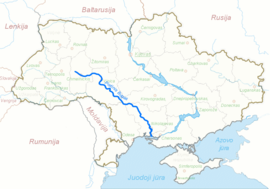| Southern Bug | |
|---|---|
 | |
 Southern Bug through Ukraine | |
| Native name | Південний Буг (Ukrainian) |
| Location | |
| Country | Ukraine |
| Cities | Khmelnytskyi, Khmilnyk, Vinnytsia, Haivoron, Pervomaisk, Voznesensk, Mykolaiv |
| Physical characteristics | |
| Source | |
| • location | Khmelnytskyi Oblast, Ukraine |
| Mouth | |
• location | Bug estuary, Ukraine |
| Length | 806 km (501 mi) |
| Basin size | 63,700 km2 (24,600 sq mi) |
| Discharge | |
| • average | 108 m3/s |
| Basin features | |
| Progression | Dnieper–Bug estuary→ Black Sea |
 | |


The Southern Bug, also called Southern Buh[1] (Ukrainian: Південний Буг, romanized: Pivdennyi Buh; Russian: Южный Буг, romanized: Yuzhny Bug; Romanian: Bugul de Sud or just Bug),[1] and sometimes Boh River (Ukrainian: Бог; Polish: Boh),[2] is a navigable river located in Ukraine. It is the second-longest river in Ukraine.
While located in relatively close proximity, the river should not be confused with Western Bug or Bug which flows in opposite direction towards Baltics. The source of the Southern Bug is in the west of Ukraine, in the Volhynian-Podolian Upland, about 145 kilometres (90 miles) from the Polish border, from where it flows southeasterly into the Bug Estuary (Black Sea basin) through the southern steppes (see Granite-steppe lands of Buh park). It is 806 kilometres (501 miles) long and drains 63,700 square kilometres (24,600 sq mi).[3]
Several regionally important cities and towns in Ukraine are located on the Southern Bug. Beginning in Western Ukraine and moving downstream, in a southeasterly direction, they are: Khmelnytskyi, Khmilnyk, Vinnytsia, Haivoron, Pervomaisk, Voznesensk and Mykolaiv.[3]
On several occasions the river served as an international border. At least following the 1768–1774 Russo-Turkish War, and more narrowly the Chyhyryn campaigns, the river became a border between the Imperial Russia and Ottomans. Some 200 years later between 1941 and 1944 during World War II the Southern Bug formed the border between German-occupied Ukraine (Reichskommissariat Ukraine) and the Romanian-occupied part of Ukraine, called Transnistria.
Nomenclature and etymology
[edit]Herodotus (c. 484–425 BCE) refers to the river using its ancient Greek name: Hypanis.[4] During the Migration Period of the 5th to the 8th centuries CE the Southern Bug represented a major obstacle to all the migrating peoples in the area. In his work Getica, Jordanes calls the river Bogossola.[5][6] Mentioning of Bogossola could also be found in works of Guido of Pisa.[6]
The long-standing local Slavic name of the river, Boh (Cyrillic: Бог),[2] according to Zbigniew Gołąb as *bugъ/*buga derives from Indo-European verbal root *bheug- (having cognates in old Germanic word *bheugh- etc. with meaning of "bend, turn, moves away"), with hypothetical original meaning of "pertaining to a (river) bend", and derivatives in Russian búga ("low banks of a river, overgrown with bushes"), Polish bugaj ("bushes or woods in a river valley or on a steep river bank"), Latvian bauga ("marshy place by a river").[7] The Polish linguist Jan Michał Rozwadowski was explaining that the name derived from the Indo-European root "water", "source", "swamp".[6] The 17th-century French military engineer and geographer Guillaume Le Vasseur de Beauplan recorded the name of the river as Bog.[8]
History
[edit]This section needs expansion. You can help by adding to it. (March 2024) |
From the 16th to the 18th centuries most of the south of Ukraine was under Turkish imperial domination and the colonists renamed the river using their language to the Aq-su, meaning the "White river". Indigenous Slavic toponyms were re-established after the conquest of the Pontic region from Turkish domination in the 17th and 18th centuries.
On March 6, 1918, the Central Council of the Ukrainian People's Republic adopted a law on the "administrative-territorial division of Ukraine", dividing it into regional districts. One of these, Pobozhia (meaning lands of the Boh, Ukrainian: Побожжя), was in the upstream lands of the Southern Bug, near the source of the river.
Tributaries
[edit]The main tributaries of the Southern Bug are, from source to mouth (length in parentheses):
- Left: Buzhok (75), Ikva (57), Snyvoda (58), Desna (80), Sob (115), Udych (56), Synytsia (78), Synyukha (111), Velyka Korabelna (45), Mertvovid (114), Hnylyi Yelanets (103), Inhul (354)
- Right: Vovk (71), Zghar (95), Riv (104), Silnytsia (67), Dokhna (68), Savran (97), Kodyma (149), Bakshala (57), Chychyklia (156)
Ecology
[edit]In October 2020, the Southern Bug was stocked with three hundred and fifty kilograms of Hungarian carp and 50 kilograms of silver carp at Khmelnytskyi.[9]
Bridges and ferries
[edit]
The Varvarivskyi Bridge over Southern Bug in Mykolaiv is a swing bridge (facilitating ship building) with Europe's largest span (134 m).[10] It is also the southernmost bridge over the river.
Navigation
[edit]The river is technically navigable for dozens of kilometers up from its mouth; several river ports (such as Mykolaiv) exist.
In 2011, plans were announced to revive commercial freight navigation on the Southern Bug upstream of Mykolaiv, to facilitate the increasing grain export from Ukraine.[11] As of April 2018, freight navigation was renewed between the estuary and a newly built grain terminal in the village of Prybuzhany, Voznesensk Raion, in the center of the Mykolaiv Oblast.
Gallery
[edit]-
Winter-frozen Southern Bug in Mykolaiv.
-
The Ploska River emptying into the Southern Bug.
-
Southern Bug in Vinnytsia.
-
A riverboat on the river in Vinnytsia (2006).
-
Riverside skyline of Khmelnytskyi.
-
Southern Bug in vicinity of the Granite-steppe lands of Bug landscape park.
-
Southern Bug in Medzhybizh
-
Historical map of the confluence of the rivers Southern Bug and Dnieper.
References
[edit]- ^ a b "Encyclopædia Britannica: Southern Buh (River)". Encyclopædia Britannica. Retrieved May 8, 2011.
- ^ a b Boh River at the Encyclopedia of Ukraine
- ^ a b Южный Буг, Great Soviet Encyclopedia
- ^ Herodotus (2009-01-30). The Histories. Digireads.com. p. 165. ISBN 9781596258778. Retrieved 2013-01-05.
- ^ Google search ("Bogossola" river Jordanes).
- ^ a b c Southern Bug (Южный Буг). www.tourclub.com.ua.
- ^ Gołąb, Zbigniew (1992), The Origins of the Slavs: A Linguist's View, Columbus: Slavica, pp. 258–260, ISBN 9780893572310
- ^
Le Vasseur de Beauplan, Guillaume (1651). Golitsyn, Avgustin Petrovich (ed.). Description de l'Vkranie depvis les confins de la Moscovie jvsqu'avx limites de la Transylvanie [Description of Ukraine from the borders of Muscovy to the limits of Transylvania]. Bibliothèque russienne (in French). Paris: J. Techener (published 1861). p. 57. Retrieved 2014-10-30.
A trois lieues audessus de Douczakow [Ochakiv] est l'emboucheure du Bog où se trouve vne isle en forme de triangle, viron de demi lieue de long le trauers de Semenwiruk. [...] Au dessus de Semenwirut, il y a sur le Bog Winaradnakricza, qui est vne fontaine sur un précipice, lieu beau et propre à habiter, tant pour le bois qui est à commodité que pour les moulins qui s'y pourraient faire.
- ^ "У Південний Буг запустили 350 кілограмів угорського коропа". khmelnytskyi.name (in Ukrainian). 26 October 2020. Retrieved 2020-10-26.
- ^ "History". Kyivdiprotrans Institute. Archived from the original on 30 December 2013. Retrieved 19 August 2013.
- ^ «НИБУЛОН» заложил основу собственного флота(in Ukrainian)
External links
[edit]- Southern Buh rafting
- (in Polish) Boh in the Geographical Dictionary of the Kingdom of Poland (1880)
- (in Russian) Photos of the Southern Buh coasts Archived 2010-06-09 at the Wayback Machine
- (in Russian) Southern Buh rafting, photo Archived 2020-02-05 at the Wayback Machine

![The Ploska River [uk] emptying into the Southern Bug.](http://upload.wikimedia.org/wikipedia/commons/thumb/2/27/Rika_Ploska_vpadaye_v_Pivdenny_Bug%2C_Khmelnitsky%2C_2005_07_28.jpg/120px-Rika_Ploska_vpadaye_v_Pivdenny_Bug%2C_Khmelnitsky%2C_2005_07_28.jpg)




